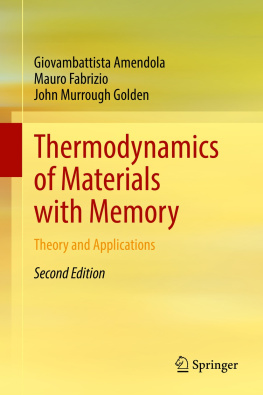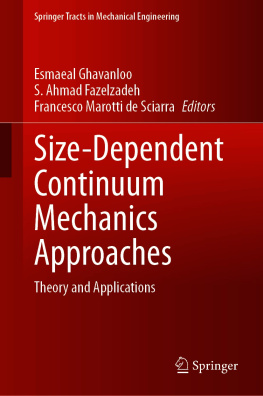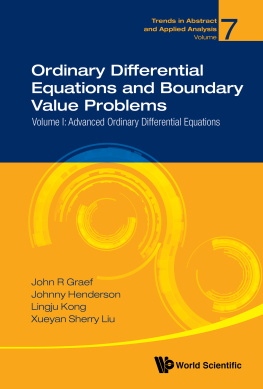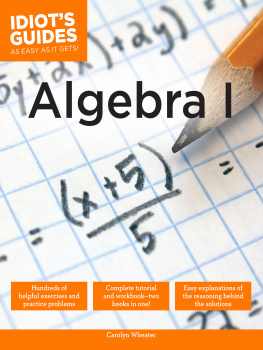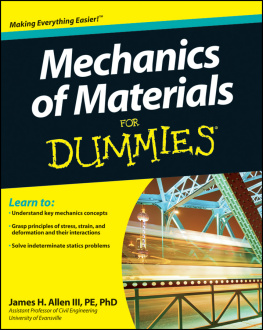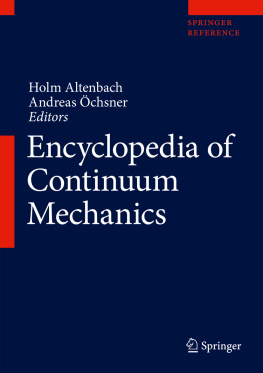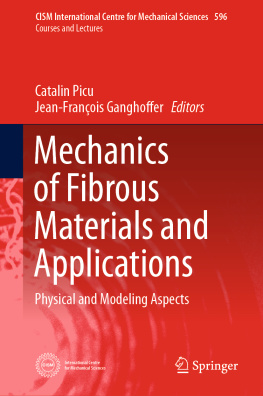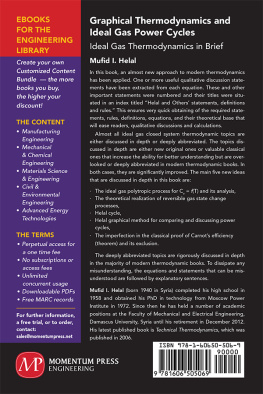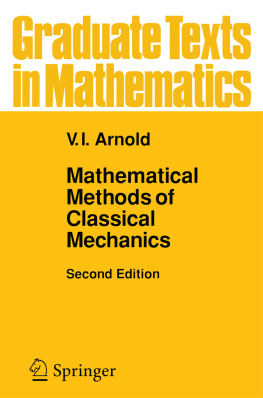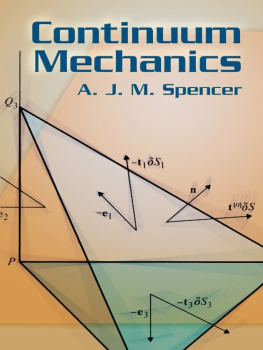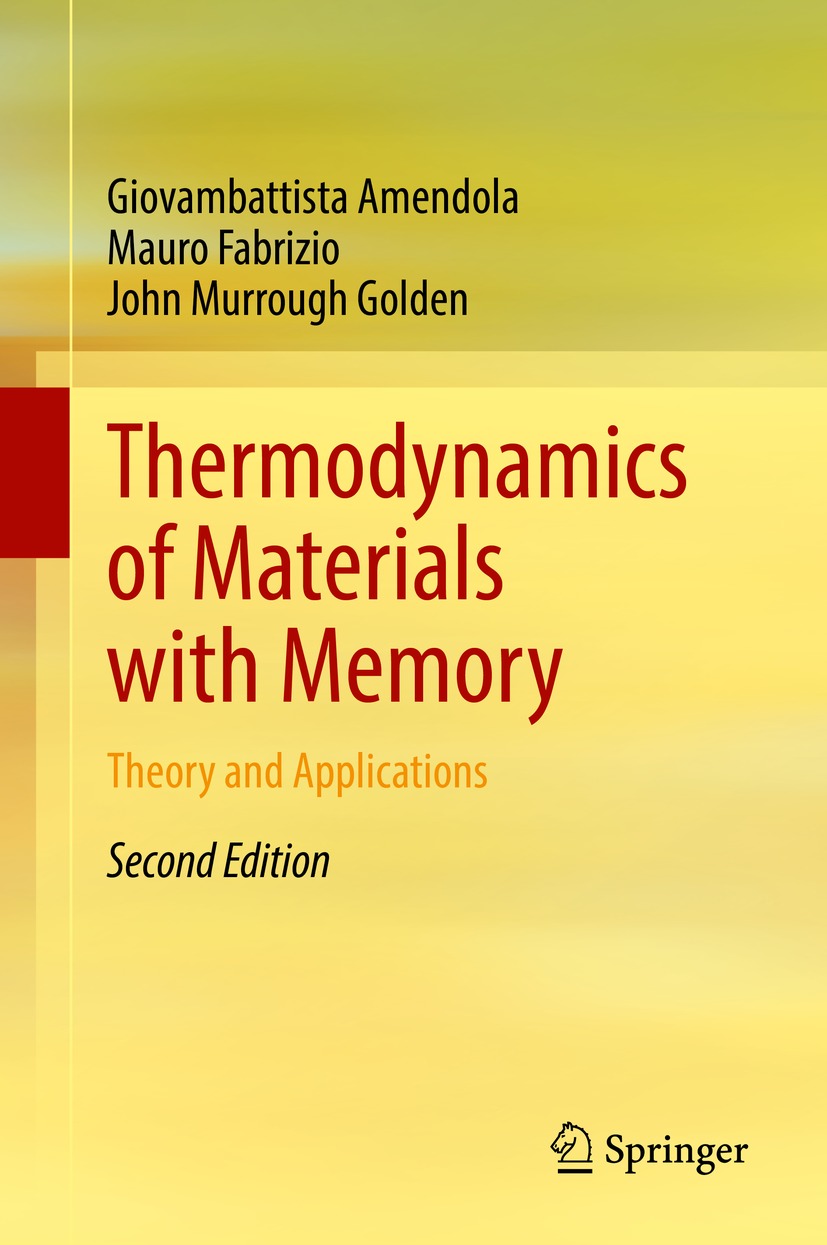Giovambattista Amendola , Mauro Fabrizio and John Murrough Golden
Thermodynamics of Materials with Memory
Theory and Applications
2nd ed. 2021

Logo of the publisher
Giovambattista Amendola
Dipartimento di Matematica, University of Pisa, Pisa, Italy
Mauro Fabrizio
Dipartimento di Matematica, University of Bologna, Bologna, Italy
John Murrough Golden
Grangegorman Campus, Technological University - Dublin, Dublin, Ireland
ISBN 978-3-030-80533-3 e-ISBN 978-3-030-80534-0
https://doi.org/10.1007/978-3-030-80534-0
Mathematics Subject Classication (2010): 74A15 74D05 30E20 35J10 35K05
Springer Nature Switzerland AG 2012, 2021
This work is subject to copyright. All rights are reserved by the Publisher, whether the whole or part of the material is concerned, specifically the rights of translation, reprinting, reuse of illustrations, recitation, broadcasting, reproduction on microfilms or in any other physical way, and transmission or information storage and retrieval, electronic adaptation, computer software, or by similar or dissimilar methodology now known or hereafter developed.
The use of general descriptive names, registered names, trademarks, service marks, etc. in this publication does not imply, even in the absence of a specific statement, that such names are exempt from the relevant protective laws and regulations and therefore free for general use.
The publisher, the authors and the editors are safe to assume that the advice and information in this book are believed to be true and accurate at the date of publication. Neither the publisher nor the authors or the editors give a warranty, expressed or implied, with respect to the material contained herein or for any errors or omissions that may have been made. The publisher remains neutral with regard to jurisdictional claims in published maps and institutional affiliations.
This Springer imprint is published by the registered company Springer Nature Switzerland AG
The registered company address is: Gewerbestrasse 11, 6330 Cham, Switzerland
Dedicated to Adele, Alessandra, and Marie
Preface to Second Edition
The major motivations for writing a second edition of this book were to include important results from a series of papers published since 2011, to present a fairly detailed discussion of thermoelectromagnetism, in particular, free energies in dielectric materials, and also to explore some features of fractional derivative models of materials with memory.
The first of these aims has resulted in the merger of Chaps. 15 and 16 of the first edition, with the omission, for the sake of simplicity, of certain interesting though somewhat peripheral topics, and the presentation of new material in Chaps. of the new edition and the omission of the discussion of nonsimple electromagnetism from Eq. (3.7.20) to before (3.7.27) in the first edition.
A few minor corrections, noticed since the publication of the original edition, have also been made, together with slight changes required in earlier chapters by the merger of Chaps. 15 and 16.
The authors would like to thank Dipartimento di MatematicaUniversit di Pisa (Italy), Dipartimento di MatematicaUniversit di Bologna (Italy), Technological UniversityDublin (Ireland), respectively, for support during the writing of the second edition. We also thank Gennaro Amendola once again for his invaluable advice on matters related to LATE X.
Giovambattista Amendola
Mauro Fabrizio
John Murrough Golden
Pisa, Italy Bologna, Italy Dublin, Ireland
Preface to First Edition
This book arose out of a conversation that took place in a bookshop in Berkeley, California, almost a decade ago. The original motivation was to provide a text on continuum thermodynamics that would allow a systematic derivation and discussion of free-energy functionals for materials with memory, including in particular explicit expressions for the minimum and related free energies, which were being developed at the time.
Progress was very slow, due to other commitments. The vision of what the book would explore broadened considerably over the years, in particular to include minimal states and a new single-integral free-energy functional that explicitly depends on the minimal state. Also, it was decided to include a detailed description of an alternative approach to the analysis of the integrodifferential equations describing the evolution of viscoelastic materials under varying loads, using minimal states and free-energy functionals depending on the minimal state. This is a novel approach to a well-known topic.
Our desire was to make the work as self-contained as possible, so chapters dealing with the general theory of continuum mechanics were included, with sections devoted to classical materials, specifically elastic bodies and fluids without explicit memory-dependence. These provided essential background to the more general and modern developments relating to materials with memory.
It was furthermore felt that certain other topics had not been covered previously in book form and should be included, in particular control theory and the Saint-Venant and inverse problems, as well as some discussion of nonsimple behavior, for materials with memory.
The book is divided into four parts. The mathematical presentation in the first three parts is largely accessible not only to applied mathematicians but also to mathematically oriented engineers and scientists. However, a higher standard is required for some of the chapters in the final part.
The authors wish to thank S. Chirita, A. Lorenzi, M.G. Naso, and V. Pata for their aid in writing Chaps. (Lorenzi). One of the authors gratefully acknowledges support for research travel from the Dublin Institute of Technology during the period of preparation of this work. All of us express our thanks to Gennaro Amendola for his very useful advice and help on certain deeper aspects of LATE X.
Giovambattista Amendola
Mauro Fabrizio
John Murrough Golden
Pisa, Italy Bologna, Italy Dublin, Ireland
February 2011
Introduction
In this work, we consider materials the constitutive equations of which contain a dependence upon the past history of kinetic variables. In particular, we deal with the constraints imposed upon these constitutive equations by the laws of thermodynamics. Such materials are often referred to as materials with memory or with hereditary effects.
The study of materials with memory arises from the pioneering articles of Boltzmann [38, 39] and Volterra [316318], in which they sought an extension of the concept of an elastic material . The key assumption of the theory was that the stress at a time t depends upon the history of the deformation up to t. The hypothesis that the remote history has less influence than the recent history is already implicit in their work. This assumption, later termed the fading memory principle by Coleman and Noll [73], is imposed by means of a constitutive equation for the stress, of integral type, which in the linear case involves a suitable kernel (relaxation function) that is a positive, monotonic, decreasing function.

